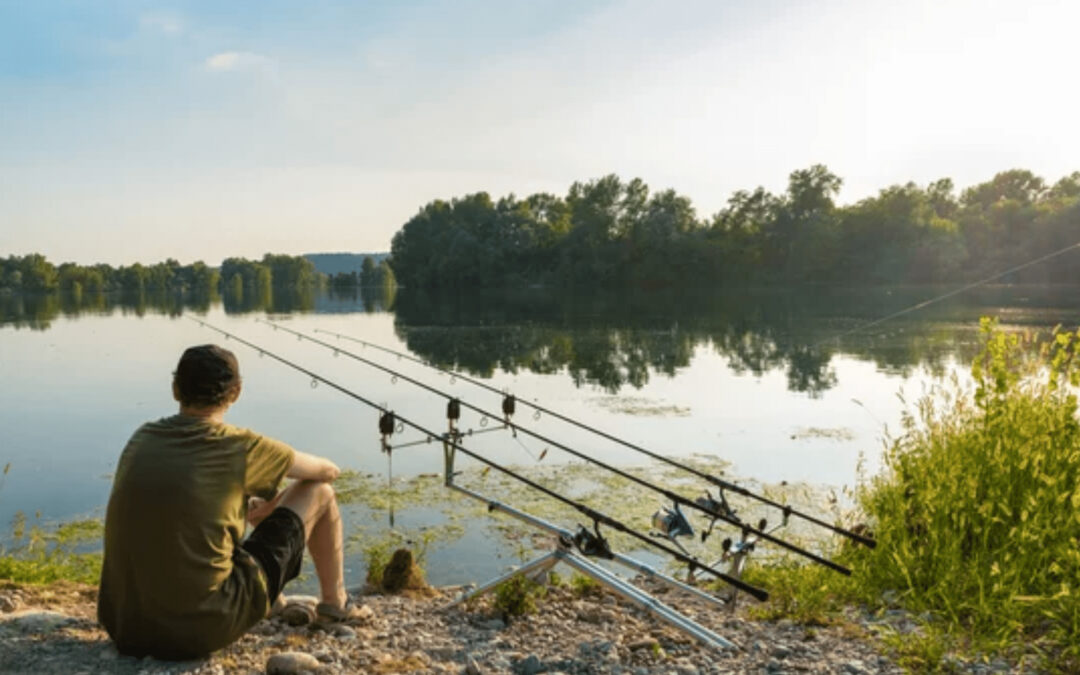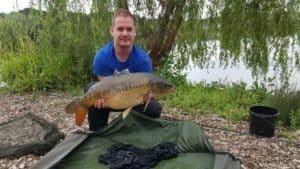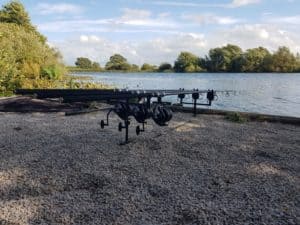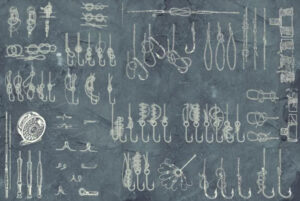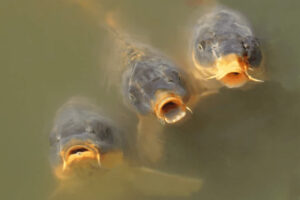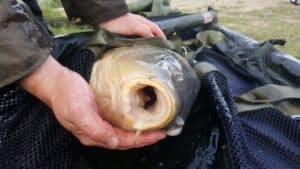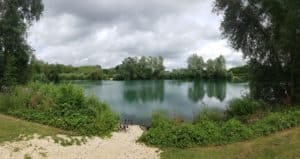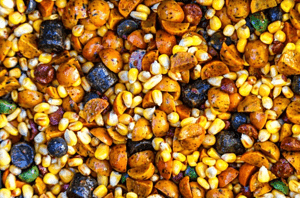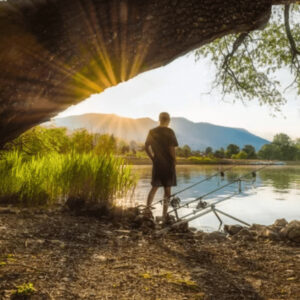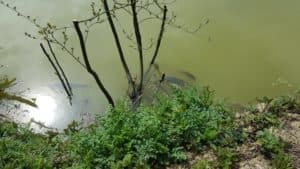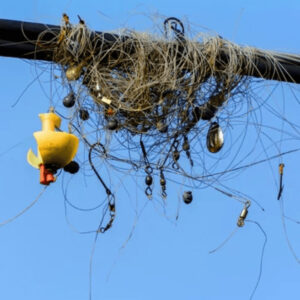Carp fishing in Summer is the perfect way to get out and enjoy the great outdoors.
Carp are an exciting species to target due to their large size and strength, making them a challenge for anglers of all levels.
Whether you’re a beginner or an expert, you’ll need to be prepared with the right tackle and gear.
This guide will provide tips on how to pack your tackle box, choose appropriate rods and rigs, and take care of your gear for successful carp fishing in the summer.
With these helpful hints, you’ll be ready to make the most of your time on the water.
Locate Fish with Sonar or Fishfinder When Carp Fishing in Summer
Fish Finders
During the hot summer months, fish will tend to rise into the upper layer of the water as the pressure rises.
Use a Deeper Fishfinder to get an indication of the depth of where the fish are. A good fishfinder will show you the water temperature, water depth, and even a 3D map of the bottom.
Using your fishfinder can help you locate the deeper parts of the lake or river where larger fish may be hiding.
If you’re fishing in a lake, look for underwater structures like points, drop-offs, and underwater humps where fish like to congregate.
Underwater Cameras
Once you locate the fish, use a sonar or underwater camera system to get an even better view of the environment and see if there are any signs of activity.
With sonar, you can tell if your bait is getting close enough to draw in any strikes and can make adjustments as needed.
An underwater camera system can offer a clear view of the water to help you spot any fish activity.
In some cases, your sonar or fishfinder may also be able to detect submerged objects like logs and snags.
These can often serve as potential hiding spots for certain species of fish.
With this information in hand, you can adjust your fishing strategy accordingly and target the right areas where you’re more likely to find success.
Monitor Throughout the Session
Once you locate the fish, it’s important to keep an eye on them so that you can adjust your technique or move to a different area if need be.
With a good sonar system, this will be easy as you can keep tabs on fish activity and make sure you’re always in the right spot.
With an underwater camera, you can also get a better idea of when to cast your line and where the best spots are for landing fish.
By taking advantage of modern technology like fishfinders and sonar systems, you can increase your odds of success when fishing in any environment.
With these tools, you’ll be able to track and locate fish with greater accuracy and precision, giving you the best chance of catching your limit.
So don’t forget to take advantage of sonar and fishfinders when out on the water!
Take Advantage of Shallow Waters When Carp Fishing in the Summer
When carp fishing in the summer, anglers should take advantage of shallow waters for two main reasons.
First, when the water is shallow, carp can be more easily spotted and targeted.
This makes them easier to catch as well.
Secondly, shallow water heats up quickly in the summer sun, making it a preferred habitat for carp.
When temperatures start to get too high for the carp, they will move into shallow water to cool down and feed.
By targeting these areas, anglers can increase their chances of a successful fishing trip.
When carp are in shallow waters, anglers can make use of various tactics.
The most important thing when carp fishing in the summer is to avoid spooking the carp.
When carp are in shallow waters, they can be easily startled and scared away by loud noises or bright colors.
Anglers should approach these areas slowly and quietly to avoid scaring the fish away.
Additionally, anglers should use lighter tackle when fishing in shallow water so as not to create too much commotion.
Utilise Artificial Baits When Necessary
Plastic corn and plastic maggots can be very effective in the hot months.
The bright colors of the bait can entice carp to bite, and the plastic material can be soaked in strong-smelling attractants.
Using smaller bait like plastic corn can also catch weary carp off guard when other anglers have been piling in the boilies all summer.
Prepare a Well-Stocked Tackle Box for Summer Fishing Trips
Before you hit the water on your next fishing trip, make sure to prepare a well-stocked tackle box.
With a few items packed away in an easy-to-carry container, you can ensure that you have all the tools and materials needed for a successful summer campaign.
Essentials: Depending on where you’re fishing, you’ll want to make sure your tackle box is stocked with the necessary end tackle.
If you plan on using live bait such as worms or maggots, store it in a separate container that can be placed inside the larger tackle box.
Additionally, pack a variety of fishing leads and rigs so you can adjust for different fishing scenarios.
Safety Gear: For any fishing trip, make sure to include several items for safety. A first-aid kit should be present with basic supplies and medications such as bandages and antihistamines.
Tools: Any successful angler needs when on the bank. A pair of needle-nose pliers are essential for removing hooks while a sharp knife comes in handy when cutting lines or preparing bait.
Additionally, be sure to have plenty of bait ready for when the fish start feeding heavily.
Small Necessities: Don’t forget about the smaller items that can make your fishing trip more enjoyable.
Sunscreen, a hat, and bug spray should all be included in your tackle box. Pack some snacks and water too so you don’t get hungry or thirsty while out on the water.
By taking the time to properly prepare a well-stocked tackle box, you can ensure that your summer fishing trip is a success. With the right supplies and safety gear, you can enjoy a safe and productive day on the water.
Monitor the Weather and Water Conditions Before Heading Out
Finally, before you set out, take the time to check the weather and water conditions. If needed, adjust your tackle box accordingly so you’re ready for whatever mother nature throws at you.
Keep an eye on the wind direction as it will have an effect on where the fish are on the lake.
By following these steps and packing a well-stocked tackle box, you can make sure that your summer fishing trips are safe and enjoyable.
Choose the Right Gear for Different Types of Carp Fishing Scenarios
In addition to having the right tackle, you’ll need the proper gear for different types of carp fishing scenarios.
For stalking, surface fishing, or floater fishing (fishing with floating bait), use a light rod that can cast accurately into tight spots.
When bottom fishing at distance, opt for a heavier rod to help with casting and line control.
For ledgering, you’ll want a rod that is designed for this type of fishing. Ledger rods are usually stiffer than your average carp rod and have a longer butt section to aid in hook setting.
Finally, make sure to invest in high-quality carp rigs and hooks that will hold up to the punishment of big carp.
By having the right gear for different types of carp fishing, you can increase your chances of catching more fish on your next outing.
Take Care of Your Tackle Box and Gear Through the Summer
Finally, it’s important to take care of your tackle box and gear to ensure a successful fishing trip.
After each outing, take the time to inspect your tackle and clean off any dirt or mud that has accumulated.
Additionally, make sure to store your gear in a dry place when not in use to prevent corrosion and rusting.
By taking care of your tackle box and gear, you can help ensure that your gear is in tip-top shape for your next fishing trip.
With the right preparation and gear, you can have a successful summer of carp fishing that will be remembered for years to come. So make sure to plan ahead and enjoy time on the water!
FAQ
What should be included in a tackle box?
A well-stocked tackle box should include safety gear, tools, bait, and small necessities such as sunscreen and bug spray.
What type of rod should I use for carp fishing?
For stalking, surface fishing, or floater fishing, use a light rod that can cast accurately into tight spots. For bottom fishing at distance, opt for a heavier rod to help with casting and line control. For ledgering, you’ll want a rod that is designed for this type of fishing.
How should I take care of my tackle box and gear?
After each outing, take the time to inspect your tackle and clean off any dirt or mud that has accumulated. Additionally, make sure to store your gear in a dry place when not in use to prevent corrosion and rusting.
What else should I consider before going fishing?
Before setting out, it’s important to check the weather and water conditions. Additionally, make sure to bring enough food and drinking water, as well as appropriate clothing and protection from the elements. Finally, don’t forget to get a fishing license if required.
What safety gear should I have when going fishing?
It is important to always use the proper safety gear when going fishing, such as life jackets, sun protection, and first aid kits.
Related Posts
I have made a lot of mistakes during my fishing sessions and don’t want you to make the same mistakes. I’ve learned the hard way over 20 years of fishing most weekends, testing, tweaking, and testing again and now want to help you excel with your carp fishing.
If you need any help, you can reach me at Fishing Again’s Facebook page
Last Updated on January 31, 2024 by Shane

